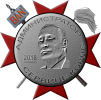Active shooter at Fort Hood, again
- Thread starter dak
- Start date
You are using an out of date browser. It may not display this or other websites correctly.
You should upgrade or use an alternative browser.
You should upgrade or use an alternative browser.
she wont have sex with you even if you put it in her sippy cupfor real, i want some DMT.
i got other stuff for those.she wont have sex with you even if you put it in her sippy cup
Izo
Tranny Chaser
- 21,654
- 31,400
That's not what I said. Sure you could make it look like that if you take my replies out of context. The guy was talking about peruvian shamans and drugs illegal 'for no reason' - not knowing about individual approval etc., conspiracy nut theories. That's what I replied to in the first place.Wrong.
Izo's claim: "Anything that hasnt been approved by FDA is pseudo-science and thus is bullshit"
Should we start digging up all the instances of FDA being wrong?
Izo
Tranny Chaser
- 21,654
- 31,400
Your avatar makes me giggle. It's wonderful, Trollface.i got other stuff for those.
I love me some opiates, don't get me wrong. I'm just not sure we need a repeat "Great Binge" like 100 years ago when we handed out morphine and cocaine for everything. Having large percentages of the population high all the time isn't the best of things.
Is there any real scientific studies on how Peruvian whateverstuff impacts people?
Is there any real scientific studies on how Peruvian whateverstuff impacts people?
- 48,947
- 107,020
Fucking scum. Pieces of shit involved in that event should of been jailed until they died.
I guess that would make y'all dogs?
Grumath_sl
shitlord
- 79
- 0
Ayahuasca is just an orally active form of DMT, which as Izo said is not new. There is quite a lot of current research on DMT going on right now, and a lot of old, incorrect, and propaganda driven research out there as well I am sure. I believe this research has picked up recently because it was just last year that they discovered DMT is naturally produced in mammal brains. Before that it was thought to only be in plants.I love me some opiates, don't get me wrong. I'm just not sure we need a repeat "Great Binge" like 100 years ago when we handed out morphine and cocaine for everything. Having large percentages of the population high all the time isn't the best of things.
Is there any real scientific studies on how Peruvian whateverstuff impacts people?
My only point in the derail was to combat the idea that psychedelics aren't being used because of factual evidence that they aren't as effective as current meds. I've seen zero evidence of that. They aren't being used because they are illegal (for no valid reasons) and because of stigmas we have been raised with of psychedelics. Politics, money, and fear have driven them out of serious consideration for treatment until very recently.
As far as comparison to opiates and cocaine, I haven't seen any reports of DMT of MDMA being physically addictive like opiates (could be wrong). Most people that do DMT do it infrequently when they need a mental reset.
Izo
Tranny Chaser
- 21,654
- 31,400
DMT was identified in the glandula pineale of rats, not humans mind you:LC/MS/MS analysis of the endogenous dimeth... [Biomed Chromatogr. 2013] - PubMed - NCBIAyahuasca is just an orally active form of DMT, which as Izo said is not new. There is quite a lot of current research on DMT going on right now, and a lot of old, incorrect, and propaganda driven research out there as well I am sure. I believe this research has picked up recently because it was just last year that they discovered DMT is naturally produced in mammal brains. Before that it was thought to only be in plants.
My only point in the derail was to combat the idea that psychedelics aren't being used because of factual evidence that they aren't as effective as current meds. I've seen zero evidence of that. They aren't being used because they are illegal (for no valid reasons) and because of stigmas we have been raised with of psychedelics. Politics, money, and fear have driven them out of serious consideration for treatment until very recently.
As far as comparison to opiates and cocaine, I haven't seen any reports of DMT of MDMA being physically addictive like opiates (could be wrong). Most people that do DMT do it infrequently when they need a mental reset.
Introduction_sl said:There is as yet no definitive information as to the possible normal or pathophysiological roles of DMT, HDMT or MDMT in humans or other species owing, in part, to the lack of comprehensive methods to detect and unequivocally confirm the presence of these compounds in biological tissues and fluids (Barker et al., 2012). Methodology to adequately assess their synthesis and turnover, simultaneously monitoring their precur-sors and metabolites, is also lacking.
You might want to hold your horses - this is an experimental method for measuring the traces of DMT. So far in rats. We do not share a full genome with rats, and as such it might be that the compound is or isn't synthetized in the analogue glandule, and it may or may not have the same pathways, receptors, selectivity, specificity or effect.Conclusions_sl said:The method described is a simple, sensitive, specific and direct approach to the qualitative analysis of compounds in the trypto-phan pathway related to the biosynthesis and metabolism of the endogenous hallucinogens, or DMTs. The method involves the direct injection of rat pineal gland aCSF microdialysate and anal-ysis by LC/MS/MS, using stringent MS confirmatory criteria, including exact mass measurements. It is anticipated that the same approach would also be viable for application to other tissue perfusates, biological fluids or samples with little or no modification. The excellent limits of detection, as well as the capacity to perform qualitative analyses for a large number of compounds in the tryptophan pathway simultaneously, without requiring extraction, make it a valuable research tool, particularly for examining the endogenous hallucinogen pathways in the CNS. We report here for the first time the presence of DMT in pi-neal gland dialysate obtained from the rat. However, the method will permit the conduct of a range of future experi-ments, such as measuring possible circadian changes or performing dialysis studies in other brain tissues or in the ventri-cles. Regardless of the sample source, it is also important to be able to assess the effects of pharmacological treatments, such as MAO inhibition or other physiological interventions, on changes in the presence or concentrations of DMT and the other endogenous hallucinogens, their precursors and/or metabolites.
We're pretty far from using this knowledge as drug targets, or even understanding the normal or pathological mechanisms. There are countless other receptors and ligands being investigated - I don't see why these need to be singled out - we don't even understand their function yet.
Your misconceptions as to why a drug is illegal - and then supposedly not available for research or treatment - is a source of concern. You're flat out wrong here. Psychedelia is an adverse effect in treatment - one pharmaceuticals try to avoid if possible. That doesn't mean that it's not being researched. Really, you need more chemical knowledge. Form dictates function, and many analogue ligands can have similar functions, but some may or may not have radical side effects like psychedelia. Tryptophane, the aminoacid part of the metabolic chain, does not illicit psychedelic effects. Serotonin is not psychedelic - yet we use it to treat. The interesting part is the common GPCR, 5HT. In short, you're attacking this from the wrong end thinking psychedelics is a no-no research subject. It's not. It's a no-no treatment when the goal is not a psychedelic one - as is the case for the vast majority of pharmacological treatments. Occam's razor - psychedelia is not needed, nor is it wanted, from a curative pov. Druggies might think otherwise, sure - nothing new under the sun.
A note on physical addiction. No apparent physical addiction does not mean a substance is safe or otherwise 'natural'. You don't illicit withdrawal symptoms from drinking, say, mercury, or eating 10 x the RDD of Iron - both is highly toxic for your body. The people you refer to are self medicating druggies. There is a reason this shit is illegal, as it is highly dangerous combination with MAOI - which is in the tea - mixed with f.inst. SRRI's - leading to serotonin syndrome, fatal. Tell me again how you can control the dosage in tea, and how it's always in a therapeutically sound and safe window. Every 'wise' lover of 'natural remedies' and herbs always think they know better than precise pharmacologically extracted and controlled substances. Really, I'm waiting - so would the Nobel committee.
I think I'll go have a proven drug, a refined piece of willow bark to get rid of this headache. What was it it called again, let me think. Aspirin.
obviously it's allowed, so APPROVED.What's the FDA's stance on garlic as an antibacterial medication?
ohkcrlho
Silver Baronet of the Realm
- 6,906
- 8,944
Opiates....fuck yes! Morphine saved my life when i broke my arm...at least for few minutesI love me some opiates, don't get me wrong. I'm just not sure we need a repeat "Great Binge" like 100 years ago when we handed out morphine and cocaine for everything. Having large percentages of the population high all the time isn't the best of things.
Is there any real scientific studies on how Peruvian whateverstuff impacts people?
chthonic-anemos
bitchute.com/video/EvyOjOORbg5l/
Lithose
Buzzfeed Editor
Why not bro? Feminists can get PTSD from people arguing with them on Twitter..so, you know, there's that.Just setting foot on Iraqi soil must induce ptsd or something. I heard a guy blow his brains out at 2am the month before I left. He must of been suffering from unbearable ptsd after only 3-4 days in country.


did she kill herself yet. maybe she should. nobody will miss her.Why not bro? Feminists can get PTSD from people arguing with them on Twitter..so, you know, there's that.


dak
Bronze Knight of the Realm
- 183
- 1
Someone should kidnap this woman and her best friend, stick them both in a trench in the middle no where and start bombing the shit out of the area for 3 days, if they try to leave the perimeter they get shot, at the end of day three after the hardship, a sniper shoots her best friend in the head.Why not bro? Feminists can get PTSD from people arguing with them on Twitter..so, you know, there's that.
Drop her off at home next to twitter.
i got ptsd from lithose's ownage on me last time. i need treatment. i accept many monies and feelings.
Share:







